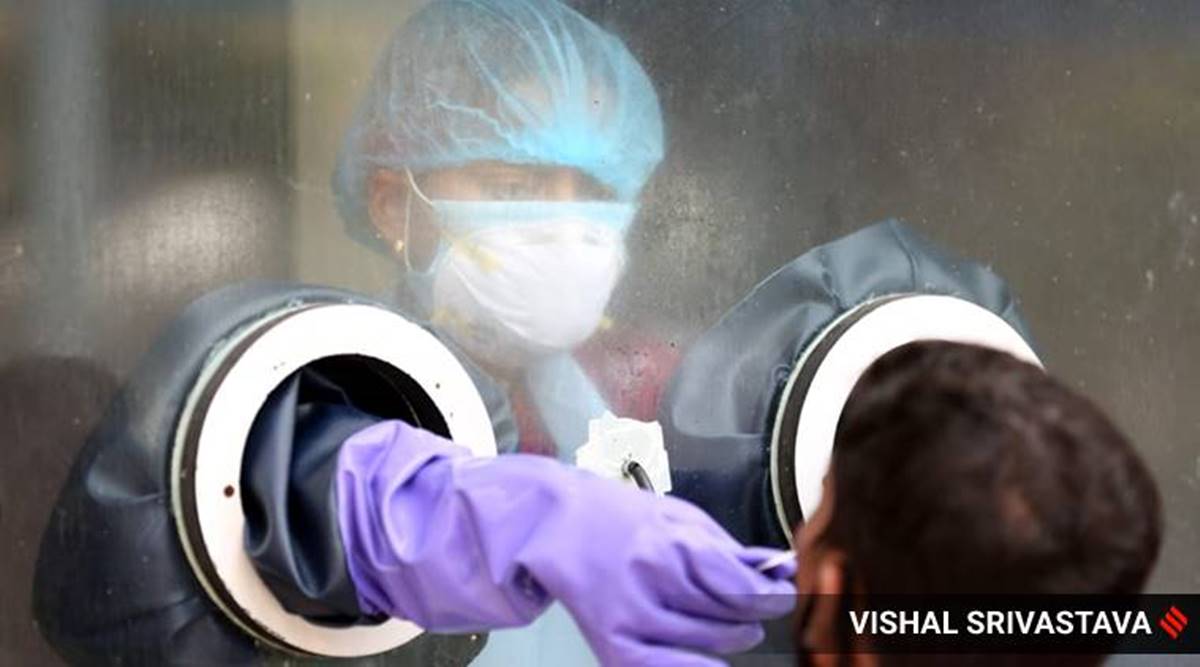Over the last two weeks, daily new detections have fallen below 60,000 on a few days, even though this has been mostly after the weekends, when testing numbers usually fall significantly.
Six months after the outbreak of the novel coronavirus epidemic — and over 27 lakh cases and 52,000 deaths later — several indicators have begun to suggest that an improvement in the situation might just be round the corner in India. Consider:
For the first time since May, the overall positivity rate in the country has begun to decline. Which means, for the same number of tests, fewer people are now being found infected with the virus.
The positivity rate touched a high of 9 per cent on August 9, and has been declining steadily since. As of Tuesday (August 18), positivity had fallen to 8.72 per cent.
Simultaneously — and not unrelatedly — there is a relative stagnation in the numbers of new positive cases being detected every day. This number has been locked in the mid-60,000s for almost two weeks – much longer than it has remained in any other range of quite some time now.
As the epidemic spreads, the numbers of new cases detected every day keep increasing – the doubling time, or number of days taken for case numbers to double, is a key indicator of the virulence of the infection. Daily new detections remained in the 50,000s for just eight days before crossing into the 60,000s. Before that, the disease was spreading even faster – daily new case numbers remained in the 30,000s and 40,000s for just about a week each. The doubling time in India overall is about to touch 30 days now.
In fact, over the last two weeks, daily new detections have fallen below 60,000 on a few days, even though this has been mostly after the weekends, when testing numbers usually fall significantly.
Interestingly, the number of new daily detections in the United States and Brazil – the two countries with more confirmed infections than India – have also peaked around the same level. On four days in July, the US detected more than 70,000 cases, but the numbers started to decline thereafter – and is currently in the 40,000-50,000 range. In Brazil, daily detections peaked at 69,000.
Overall, the US and Brazil have seen about 54 lakh and 34 lakh infections, with 1.7 lakh and 1.1 lakh deaths respectively.
In India, a few other indicators too, correlate well with the broad trends of declining positivity rates and plateauing daily case numbers.
Explained| Can a recovered patient be re-infected with Covid-19?
The daily growth rate of cases has been declining steadily and, at 2.49 per cent, is at an all-time low. So too, the reproduction number, or R, which describes the number of people who are infected by an already infected person on average.
The R-value for the country as a whole in the period between August 11 and August 15 has been 1.06, meaning every group of 100 infected people are transmitting the virus, on average, to another 106 people. This number, which is a measure of how quickly the disease is spreading in the population, has not been this low since the beginning of the outbreak in March.
When the R-value drops below 1, it usually signals the beginning of the end of an epidemic. However, the situation is evolving, and these numbers are as of now only estimates, which are open to change.
The decline in the positivity rate has come about despite a significant increase in the number of tests that are being carried out every day.
Coronavirus Explained
Click here for more
When the number of new cases first crossed the 60,000 mark in the first week of August, around 6.5 lakh samples were being tested every day. Now, about 8.5 lakh samples are being tested daily. Usually, more tests result in more detections; the fact that daily detection numbers have remained more or less flat in the mid-60,000 range suggests that the spread of the disease could be slowing.
This would certainly be true if the tests were being conducted randomly. Importantly, however, that is not what is happening.
Most states are still relying on targeted testing, meaning only those who are showing symptoms of the disease, or those who are close contacts of an already infected person, are being tested. A move to more random testing could trigger a decline in the positivity rate – because targeted testing, by its very nature, returns a higher positivity.
But there could be another, more significant, prism through which to look at this decline.
The recent serological survey in Pune, one of the worst affected cities in the country, found that more than 51 per cent of surveyed people had antibodies for the disease – suggesting that half of the population could already have been infected.
Such a high level of disease prevalence might not be present uniformly across the country, but a series of similar serological surveys indicate that it has been much more widespread in the community than the numbers of confirmed infections suggest.
When the spread of the disease reaches such levels, there are far fewer numbers of people who can potentially get infected. In random testing, therefore, a large number of people who have already been infected but who have never been tested would also get picked up – and these would turn out to be negative, thus bringing down the positivity rate
? The Indian Express is now on Telegram. Click here to join our channel (@indianexpress) and stay updated with the latest headlines
For all the latest India News, download Indian Express App.
Source: Read Full Article








